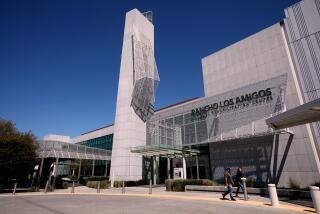Primary-Care Physicians Become a Hot Commodity : Medicine: With the nation moving toward a gatekeeper system, hospitals depart from wooing specialists. Now they are scrambling to recruit family doctors.
In the shadow of Torrance Memorial Medical Center, workers are putting the final touches on a refurbished building that embodies a cutting-edge trend in U.S. health care.
The trees are planted; the stylish signs are in place. Soon the building will be occupied--not by high-tech laboratories or fancy imaging equipment, but by a group of family practitioners.
Suddenly, down-to-earth family doctors are so much in vogue that Torrance Memorial has renovated this Skypark Drive office complex to house as many as 14 family practitioners and internists. Several other hospitals in the South Bay report that they, too, are trying to attract more primary-care doctors.
A key reason is that these physicians will play a central role in the managed-care system that is swiftly becoming the norm in the U.S. medical world.
“All hospitals realize that primary-care physicians will be the gatekeepers of tomorrow’s health-care system. They naturally want as many gatekeepers as possible,” said William Erwin, a spokesman for the Chicago-based American Hospital Assn.
For years, primary-care physicians--an umbrella term referring to family practitioners, internists and pediatricians--have enjoyed less prestige and clout than specialists.
Under managed care, however, these physicians will serve as a patient’s gatekeeper--assuming primary responsibility for a patient’s care and calling in specialists if needed.
*
Because doctors historically have flocked to high-paying specialties such as surgery, experts say today’s medical schools are not producing enough primary-care doctors to meet the expected demand. So, as the Clinton Administration readies a health-reform plan based on managed care, many hospitals, managed-care companies and group practices nationwide are scrambling for primary-care doctors to prepare for the new era.
In California, private hospitals are prohibited from employing doctors outright, and federal laws prohibit a too-cozy relationship between hospitals and physicians.
“You can’t just go to a doctor and say we will pay you $200,000 to come here and be affiliated with our hospital,” said Phil Miller, director of communications for Merritt, Hawkins & Associates, a large Texas-based physician recruitment firm.
*
So hospitals are trying other approaches, such as renting office space tailor-made for family doctors or helping new physicians set up their practices.
Torrance Memorial hopes that about 14 family practitioners and internists will choose to move into its one-story Family Medicine Center, a former Hughes Aircraft Co. office building purchased by the hospital. The complex also houses the hospital’s Breast Diagnostic Center, which moved there in July.
Four to five family doctors are due to move into the building in October, and more are expected, hospital officials said.
“We’re trying to make it easier for primary-care physicians to move here, because we know the community will need them,” said Sally Eberhard, vice president of planning and marketing for the 340-bed nonprofit hospital in south Torrance.
Doctors who practice in the Torrance Memorial building will pay rent, but the hospital will provide such services as billing, nursing staff and supplies, for which doctors will pay management services fees.
“The doctor doesn’t need to worry and go through the administrative difficulty of setting that all up,” Eberhard said.
Several other South Bay hospitals report that they, too, are hoping to attract more primary-care physicians to practice in their areas.
One community that needs more such doctors is San Pedro, according to Little Company of Mary Health Systems, which operates Little Company of Mary Hospital in Torrance, and, since last year, San Pedro Peninsula Hospital. By this fall, it hopes to have helped draw five to six doctors to the community, said Blair Contratto, vice president of corporate development for Little Company of Mary Health Systems.
For new doctors, the hurdles of starting a practice alone can be formidable, experts say.
“They’ve never done it, and they’re not taught it in medical school,” said Contratto. So Little Company of Mary offers management services for a fee.
One new physician getting help from the hospital is Dr. Nina Cunha, who recently completed her residency in family medicine at Los Angeles County Harbor-UCLA Medical Center. She will open a private practice in San Pedro in September.
A hospital representative helped Cunha look for an office, and she is also getting guidance on how to maneuver her way through the maze of paperwork required to launch a practice.
“Little Company is very good. They explained what private practice entailed,” said Cunha.
In Inglewood, meanwhile, Daniel Freeman Memorial Hospital hopes to attract three new primary-care physicians in the coming year to ease what hospital officials report is a shortage of such physicians in the area.
Memorial Hospital of Gardena is searching for primary-care doctors too.
“We’re just constantly looking for them,” said public relations director Lisa Ciccanti. “We’re definitely trying to recruit primary-care (doctors), because the managed-care business is the way it’s going.”
More to Read
Sign up for Essential California
The most important California stories and recommendations in your inbox every morning.
You may occasionally receive promotional content from the Los Angeles Times.










